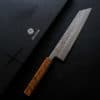OTANI Toishi Kitayama Finishing Japanese Whetstone # 8000 + Kikusumi FIXIT Polish
$79.00
Otani Toishi Kitayama 8000 Grit Whetstone Set for Knives + Knife Fixit Polish/Cleaner – Finishing Whetstone
SPECS:
GRIT: # 8000
TYPE: Splash & Go
DIMENSION: 205 x 75 x 25mm (11.3 x 3.9 x 2.6″)
WEIGHT: 778g (27.44oz)
MAKER: Otani Toishi
LINE: Kitayama
MATERIAL: Synthetic high purity alumina composite
COLOR: BEIGE
ORIGIN: Kyoto, Japan
*This stone does NOT come with stand or Nagura
#8000
The Kitayama #8000 is a highly refined polishing whetstone that outperforms many other pricier whetstones in the same grit range. Many 8000 grit whetstones tend to feel a bit dull, and soft, but this whetstone still retains enough feedback to allow the sharpening to know what is happen with the knife. The mirror-like finish quality is perfect for everyday and high-end commercial kitchen use.
USES
Super fine #8000 stones will remove surface scratches created by the abrasive action of the medium stone and will polish the edge to a precision mirror-finish. A fine stone is absolutely essential to hone traditional Japanese blades.
They resist dishing well are an excellent choice for uraoshi sharpening (single edge knife and microbevels.
DURABILITY
Otani Kitayama are harder than most similar grit stones and will resist wear and offer long-lasting durability. These stones work superbly on stainless steel and high-carbon steel knives and tools.
COLOR & AESTHETIC
Creamy yellow color. A simple, clean aesthetic accented by beautiful kanji lettering make these whetstones a pleasure to use. Packaged in a paper box printed with a photograph of the Kitayama evergreen forest. Inked markings include the Kitayam kanji and grit number. One of the better looking stones on the market with a classical and natural stone look.
MATERIAL COMPOSITION
Otani Kitayama standard synthetic sharpening stones, made from materials such as Aluminum and Silicon Carbide, are versatile and easy to use. They are suitable for a wide variety of knife steels.
BLADE FINISH
The #8,000 grit stone is the best finishing stone for the sharpest and most polished blade. We recommend this stone for those working with mostly produce and non-fatty ingredients.
WHY NO BASE?
It is better to have no base so both top and bottom of the stone can be used which saves time flattening the stone. The bases are not reused so become garbage which contributes to the environmental damage. If you want a much better solution try the Kikusumi Hinoki Wood Whetstone holder.
HOW TO USE
Do not soak this whetstone. Simply apply water on the surface when ready to use. Rinse and wipe dry with a hand towel when done, and allow air dry at room temp. Do not leave in water.
HOW TO LEVEL
With use, a synthetic stone will become slightly concave in the middle and, as a flat surface is necessary for sharpening, they need to be leveled out routinely with a stone fixer.
HOW TO CLEAN
We also conveniently include a Polishing/Fixing/Rust Eraser for maintenance of the stone surface such as removing metal bits and stains. If the stone’s performance is slowing down, or seems to be diminishing, you can clean using a rust eraser, nagura stone, dressing stone, or a flattening plate. Be sure to clean the entire surface of the whetstone when using any of these methods to ensure even wear of the whetstone’s surface.
WHY WHETSTONES
To obtain a truly sharp edge, you must hand sharpen your Japanese knives with Japanese water stones. The process of sharpening on a stone is like sanding wood. Each pass of the whetstone cuts away material from the blade . Dividing the blade in stages allows the sharpener to shape and polish the metal to an acute edge. Water stones come in a broad range of grits, from very rough to fine, for this purpose. They are referred to as water stones as water is the lubricant adding the sharpening process.
OVERALL
Outstanding standard whetstone at a reasonable price for its top quality. Provides sharpening akin to that experienced with a natural stone but offers greater consistency. Cuts faster and better than similarly priced stones. Grit #8000 feedback and tactile feel make Otani Kitayama whetstones one of the best you can buy. Otani Toishi is one of the more artisanal manufacturers in Japan and a favorite whetstone maker of Kikusumi.
SHIPPING INFO
Please provide a telephone # for the courier to contact at the time of purchase.
HANDLING
We generally shipped your order within the next 1 to 2 business days.
*We will deliver the products in stock immediately
PRODUCT PHOTOS
The picture showing on the item page is a representative image of the product. The product shipped will be similar but please be aware the actual color, pattern, shape and size may slightly differ from the pictures shown regarding items hand-made by the artists and made using natural materials such as wood.
— TAX & DUTIES —
Import duties, taxes and charges are not included in the item price or shipping charges. These charges are solely the buyer’s responsibility.
Please check with your country’s customs office to determine what these additional costs will be prior to bidding/buying.






























